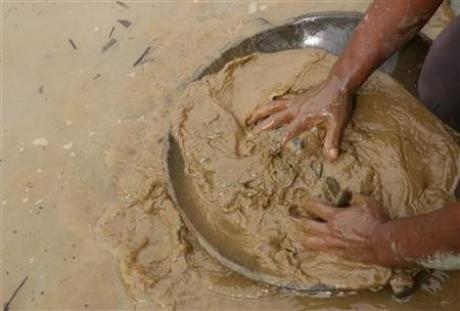| You are at Toxics Alert > Report > Mercury Poisoning, The Dark Side Of Colombia's Gold Boom | |||
 |
 |
||
|
Subscribe || Tell a Friend || Print View | ||
| Home | Editorial | Feature | Interview | News | Policy | Updates | Reports / International News | Partner | |||
|
Mercury Poisoning, The Dark Side Of Colombia's Gold BoomSource: http://planetark.org/enviro-news/item/58771, Date: , 2010Colombia's gold bonanza has a dark side, U.N. experts said on Tuesday: mercury poisoning spreading from miners to the population of a northwest state where they use mercury to extract the precious metal, U.N. experts said on Tuesday.
 Colombia is one of the world's top mercury polluters, as 50 to 100 metric tons of mercury are lost annually in the process of capturing gold while soaring prices push miners and artisans to extract ever more of the yellow metal, analysts say. "As prices of gold have been increasing, more artisanal miners are mining and processing gold using mercury which is accessible, easier and cheaper to use," said Marcello Veiga, an adviser to the U.N. industrial development arm. The Andean nation is the world's No. 1 mercury polluter per capita from artisanal (small-scale) mining, Veiga said. "The number of artisanal miners in Colombia is also increasing." Miners have used mercury to separate gold for decades, but part of it is lost in the process, contaminating rivers and soils. The environment ministry currently allows mercury but may soon forbid it, with a few exceptions. In northwest Antioquia state, they use the most damaging process, adding around 120 grams (4.2 ounces) of mercury to 60 kilograms (132 pounds) of ore, without condensing or capturing the mercury, Veiga said. As a result, mercury levels in some urban areas of Remedios, Segovia and Zaragosa can be 1,000 times higher than the levels accepted by the World Health Organization, he said. "Around 15 kidney transplants are carried out in Remedios every year ... because mercury vapor stays in the kidneys, damaging them," Veiga said, citing data from the Remedios department of health. 50 TONNES OF MERCURY Antioquia -- the country's largest gold producer, according to the energy ministry -- has about 15,000 to 30,000 artisanal miners producing between 10 and 20 metric tons of gold per year. But the miners are releasing 50 metric tons of mercury annually in the municipalities of Remedios, Segovia, Zaragosa, El Bagre and Nice, where 90 percent of the population depends on gold mining or jewelry for their livelihood, Veiga said. Colombia is experiencing a gold boom with more than 40 companies exploring for the metal and production likely to grow over the next two years to around 3 million troy ounces (93.3 kilograms) of gold, the mining regulator says. The United Nations calls for a gradual elimination of mercury in mining as miners switch over to use of centrifuges, which allow for greater gold extraction than mercury. "With the centrifuge, small miners can produce twice as much gold than using mercury without affecting their health or the environment," said Monica Roeser, who leads the Global Mercury Project in Colombia for the United Nations. Studies of children have detected attention deficit disorders, memory and language problems in Segovia and Remedios, the project has reported. Among miners, mercury exposure can be linked to memory loss, language issues and chronic headaches, researchers say. "We don't know how many people may have died from mercury pollution because neither doctors nor nurses have instruments to analyze whether mercury is in the urine," Veiga said. |
•
Home •
FEATURE •
INTERVIEW •
NEWS •
POLICY •
UPDATES •
REPORTS / INTERNATIONAL NEWS •